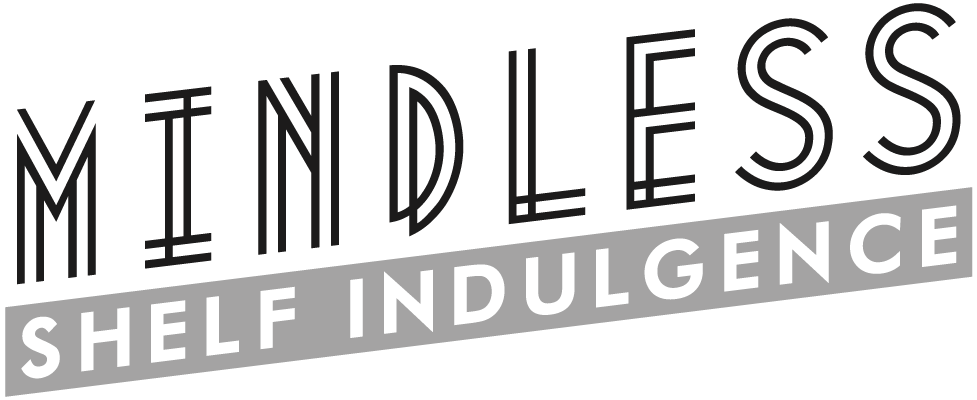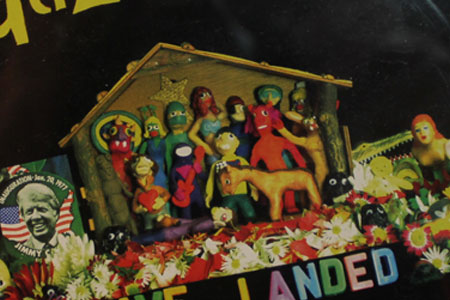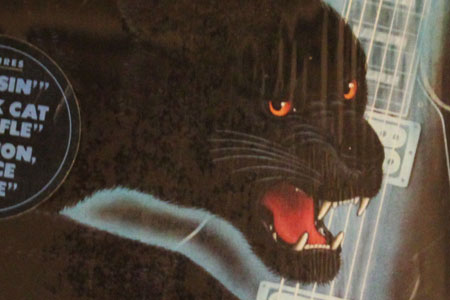For a couple of years in the early 2000s, I ran a small Sunday morning AM radio show on an upstate NY college campus. I called it Delicious Radio, and I don’t think anyone ever listened to it, but it was a mix of vintage Batman radio shows I’d found on LPs, Magnetic Fields, some concertina playing during breaks, and one instance of the Dean of the school getting pretty pissed off at me because my musical selections were not to his taste during an important tour of the building. During my tenure, one of the requirements of being a DJ was taking home a few CDs a week and listening to them, highlighting the best tracks, and warning other DJs of any profanity that might appear on the album so we wouldn’t accidentally violate any FCC rules. The best CD I borrowed while I was a DJ was The Gazillions Have Landed. I played a track or two every week for about two years, whether or not the album was in the required rotation set that had to be played.
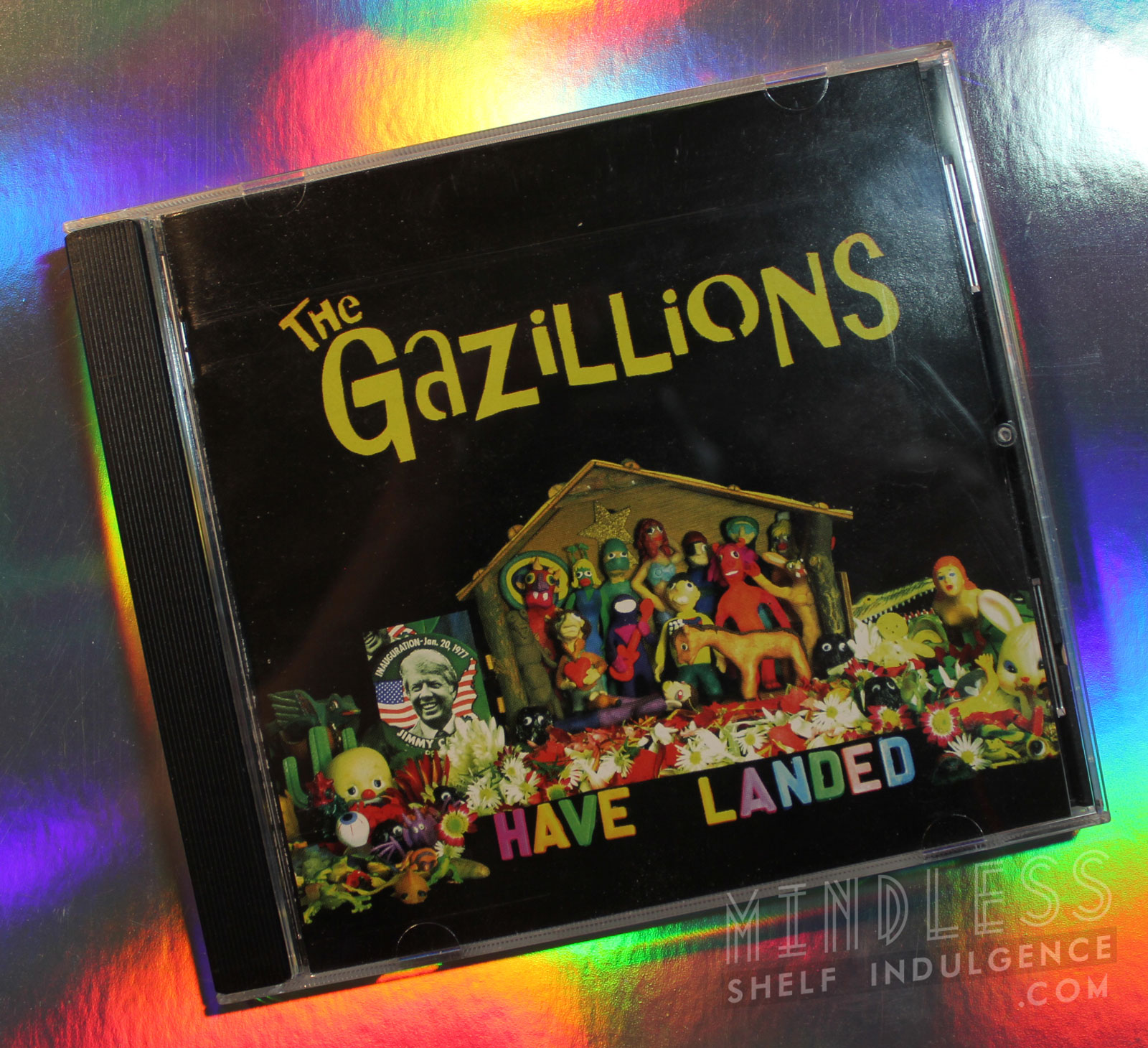
It got into my bones. It’s not an album about pop culture; it would be easy to assume, based on the truly great, subtly gross and romantic song ‘Hobbit Love’. It’s not an album about sci-fi, even though there’s plenty about spaceships, lasers, and genetic mutation. It’s not even an album necessarily about being a kid, even though it has songs about classrooms and has all of the remorseless id-driven energy of what it’s like to be a kid. It’s a friendly cartoon of punk rock; a collection of songs about the coolest stuff you can think of, if your brain is still justifiably fascinated by the same things you were when you were 10. We all were one aspect of our best selves in the 5th grade, and The Gazillions Have Landed lives somewhere in that space.
Instead of advocating punk rock anarchy, The Gazillions just want to blast into space and find a whole new world to explore and aliens to chill with. As a new art school student who didn’t know what art even meant anymore, it gave me a direction. Here was legitimately cool art about mermaids and Jimmy Carter. I became more comfortable being myself in my art and leaned into prints of robots, and illustrated stories about astronomers falling in love with luminous ladies on the moon.
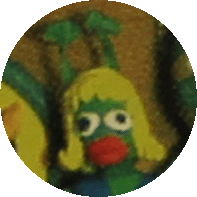
It wasn’t until a few years after college when I was trying to find some kind of follow-up album that I realized that there wasn’t one. The Gazillions barely existed on the Internet, having been formed during an era where most of what was on the Internet had already been tossed out. The liner notes weren’t too helpful, directing me towards a nonexistent guy called David Hologram. I spent many nights trying to figure out who they were, and trying to filter out results from the Gazillion Bubble Show and a newer band that popped up using the same name. The closest I came was a stroke of luck when I contacted a musician with the same kinda-common name as someone in the band.
I lost the conversation years ago in the guts of a dead Twitter account, but he informed me that I was on the right track, that there might be an un-mastered second album out there somewhere, and that I’d have to dig deeper to find who seemed to be the brains behind the bombastic band, David Hologram. I didn’t want to pry into anyone’s privacy, believing I could still find the answer. I didn’t.
It wasn’t until 2019 that someone posted a message on Discogs below the only Gazillions album that provided an incredible lead. I was able to follow a convoluted trail to Gazillions-adjacent people. Through an amazing coincidence, even though The Gazillions were a California-based band, one of these people lived a couple of towns over. It was also 2020, so going exploring to meet and chat about some one-album band from the early aughts was out of the question for anyone but the most viral of plague rats. But eventually, after an on-and-off search that spanned almost 20 years, and with the help of some pretty generous people who were willing to give me some clues, I found David Hologram.
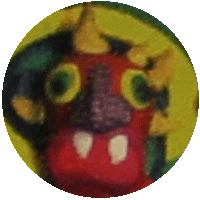
“I am David Hologram.”
Or Little Johnny Bowling Ball. Or Derek Lindsay. Or one of many other characters that have emerged for Hologram’s many high-concept-but-completely-accessible projects that have come and gone over the years. The Gazillions just happened to be the biggest one, and like many weird and colorful things, it somehow made it all the way to upstate New York.
“The Gazillions album […] is the culmination of about ten years of work,” says Hologram, though the 15-song set that appears on the CD was the direct result of two years of practice, and a couple of weekends in a studio. While the band would eventually break up during the recording of the unreleased second album, like many young bands do, this was neither the beginning of end of the creative story of Hologram, who says that the Gazillions only lasted for a short period between 1998 and 2000. By the time the CD was on New York college radio in late 2000, the band was probably already no more. Before The Gazillions, Hologram recorded a 5-tape box set called The Banjo Krsna Chronicles, performed with Mr. O’s Traveling show and the Blue Kanobees, as well as created and managed other themed projects. Have Landed was a culmination of things, but those things would continue to culminate for another 20 years.
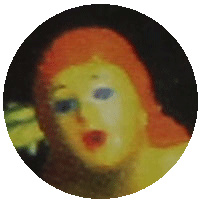
That first culmination started on a bus, when Hologram met his chief collaborator in 1990, who he makes clear is an equal part of the Gazillions experience. “Anthony [da Rosa] and I literally ‘met’ on the Greyhound on the way to [Humboldt State] University. He got on in San Francisco and had his guitar in a pillowcase. […] Within a week or so he sat down next to me in the dining hall and I couldn’t wait to show him the crate of LPs that I had brought with me.”
“Soon after we literally went down to Jolly Giant Creek and jammed, he on guitar and me on banjo. He had very strong vocals and over the next years we called it ‘shed music’ after one jam we had in his shed. […] By 1994, we played with all of our college friends and called ourselves the Blue Kanobees. That is my favorite band of all.”
By 1995, Hologram was driving a cab and processing all of the hours of improvised Blue Kanobees tapes, some of which later evolved into Gazillions songs. Other Gazillions songs emerged from this time period, too. “‘Thanks for playing Scrabble’ was something that was said to one of my fares by her host as she got in the cab,” recalls Hologram. This period of time, until 2006, was immensely productive creatively. Hologram produced a Blue Kanobees album with a 4-track recorder, and spent the next bunch of years recording copious amounts of songs and demos. “We met the rhythm section of The Gazillions while performing [as Mr. O’s Traveling Show] on KALX radio at UC Berkeley.” Drummer Jason Smith joined the band, and Ricardo Esway joined on bass. And the rest is history, although a brief one.
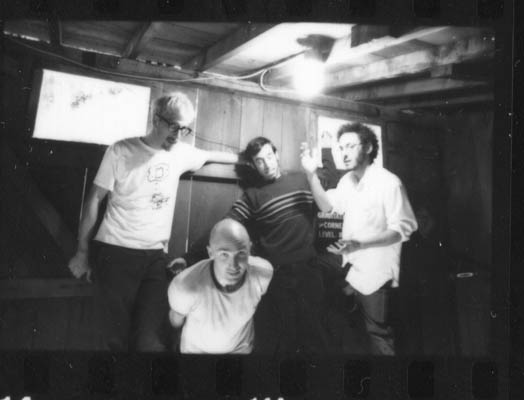
Without many images of The Gazillions out there, it’s always been a little difficult to complete the picture of exactly what was going on behind the music, but it was clear there was a concept there. Panache Magazine [via Robots and Electric Brains] published one review of a Gazillions show that didn’t really clear anything up :
“The eccentrics of this gallant band urged the audience members to question their humanity. Were they another life-form advancing from the planet Mars? Or were they merely out of balance human beings with several thousand brain cells on a frenzy causing their dementia? Whether or not they’re one of the Earth’s kind, this band knew how to enrapture a crowd. Their indescribable antics and catchy lyrics were both addictive and mind boggling. I am definite that their songs like “Thanks for Playing Scrabble” and “All the Kids Are Eating Prunes” were stuck in everyone’s head the next day.”
It all seemed too difficult to capture in words. A 2007 reunion show summary stated, “The evening is brought to you by the Gazillions, who (in addition to playing their first live show since their lead David Hologram was shot on stage by his arch-nemesis over five years ago), will be presenting satellite bands that members of that group have gone on to form: Uncus, The Mothballs, The Trenchermen, The Bleu Canadians, and Bunny Numpkins & The Kill Blow Up Reaction.”
Hologram, maybe the only person who could really, actually encapsulate what it was all about, was gracious enough to confirm some of my initial suspicions. “Many of the songs and concepts in The Gazillions were kind of like my autobiography until maybe age 14, so David Hologram was kind of like an Elvis movie. I was getting the band to dress up by the end so it was starting to become like Sid & Marty Krofft. The sci-fi is from things like Buck Rogers, Flash Gordon, Battle Beyond the Stars and all the 1970s sci-fi craze after Star Wars.”
The idea that The Gazillions are both influenced by pre-teen fascinations and post-George Lucas sci-fi is very pleasing. It’s an unfiltered world of the organically, enthusiastically strange. The band itself was a shifting collection of characters.
“I tried out a new character named Sir Bjorn Orange who was like a whiny Kurt Cobain from the MTV Unplugged concert. I got Anthony to dress up like Sir Bjorn Orange (who is one step away from an Otter Pop, more pre-teen autobiography) and the bass player dressed like David Hologram. I dressed like the green guy, because I was swimming A LOT and could carry off a lycra bodysuit.”
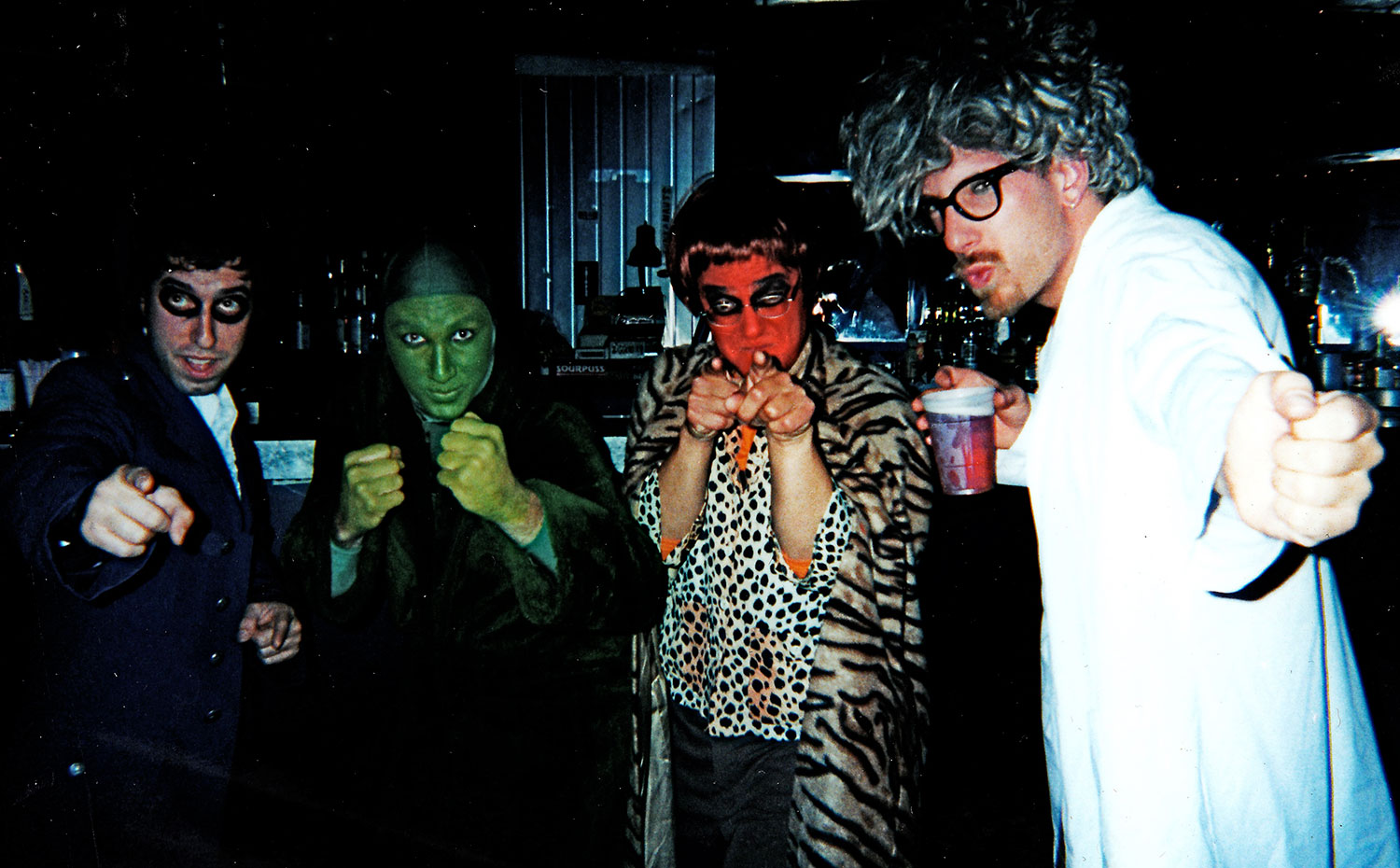
Ultimately, the band’s musical tastes were too divisive. “I wanted everyone to sound more like The Mamas and the Papas. Now I look back at their arrangements and find them amazing, but at the time I had a tremendous ego to be massaged and probably pouted too much.” Subsequent projects were comparatively smaller, without anyone else functioning as a producer or manager. By 2004, The Gazillions morphed into The Bleu Canadians, “an improved version of The Gazillions”, but they too slowly went their own ways. With the incomplete masters of the unfinished Gazillions album shelved, “Where Horses Eat Men” didn’t seem like it was ever going to happen.
Anthony da Rosa (who also sings on some of the original Gazillions songs) went on to form The Trenchermen, performing more original music and some Where Horses Eat Men castoffs, including ‘Bubble Machine’. Hearing the duo split off spells out pretty clearly where all of The Gazillions’ sounds came from, and come together, and just what a miraculous union the band was. Angel Soft is one of those great songs that sounds both like and unlike The Gazillions in alternating moments.
Bassist and co-producer Ricardo Esway became one-man band, The Militant Children’s Hour, a completely awesome, out-there sci-fi entity that brings to mind The Residents, and some of the costumed storytelling elements common to The Gazillions. Drummer Jason Smith joined garage band The Mothballs; a Discogs user reviewed their 7″ by saying, “I particularly enjoy the first track. It’s an absolute dirt recording, which totally fits the style.” The same user goes on to describe these recordings as “artifacts to capture the moment”, which is a monumentally important thing.
Hologram moved on to other projects like BanJoctopus (about “about The Semi-Animated Adventures of Chuck Berry at Sea”), Bunny Numpkins and the Kill Blow-Up Reaction, and The Primitive Sounds of Mr. Whiskers by Little Johnny Bowling Ball (about the troubled life of a person who is half human, half bowling ball). The constant creative motion was motivated by one beautiful idea of what it means to be successful as an artist:
“I became more grateful at this time and I measured success by having an active project.”
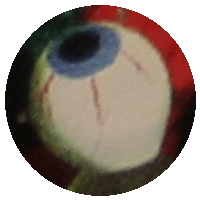
“My best songs lyrically come from trying to make my friends laugh. But a lot of it is just journals that tell my story in metaphors. […] Musically, many are just cool math problems,” says Hologram. And it’s a theme that seems to run through all of Hologram’s projects; they’re uplifting and free from malice. None of them do anything so obvious as talk about the act of being uplifted and how to get there, but it’s these observations of both microscopic ideas made huge, or macroscopic ideas broken down to an observable scale, that subtly paint a picture of a universe that will never cease to amaze and delight.
Little Johnny Bowling Ball was finished in May of 2020, “a pile of demos” that were stitched together, like a sketchbook of song fragments recorded in dozens of different ways, with countless sounds and atmospheres. Hologram is also planning another culmination of decades of writing and recording, a “retirement” album that functions as a kind of autobiography of his 20s, much like The Gazillions were a chronicle of earlier years. “I intend to use the wisdom of age to interpret those times and also inject any themes that I am currently obsessed with. It may come across as words to my son if I am my own father.”
In mid to late 2020, the Gazillions all met again at the home of Esway for the first time since their reunion show 13 years prior. The master tapes for “The Gazillions Have Landed” were given to Anthony da Rosa, as well as the masters for “Where Horses Eat Men”. It’s here where that amazing and delightful universe kinda comes together again.
For about many years, it had been my deeply selfish goal to somehow manifest, will, nudge, fund, summon the missing album into existence, even though The Gazillions had been unfindable, and probably not interested. I really just wanted to hear the rest of the story. And David Hologram agreed. It’s exciting to talk about art, and how artists approach art, and how one might measure creative success in a crowded world; the conclusion that’s inevitable here is that to just create something is to find success. It’s a sacred act.
“Where Horses Eat Men” is probably happening, and with Hologram’s ability to look back on an old notebook of songs with 20 more years of experience and knowledge. I couldn’t be more excited. Hologram seems pretty excited too. “It turns out there is a lot of nostalgia in that Where Horses Eat Men set.” It’s a great time to return to a world where rockstars are escape a war-torn planet, the innocence of Jimmy Carter, and where playing Scrabble is a great way to hone your superpowers. It may be one of the longest between-album breaks in musical history, but it’s been worth waiting for.
 C. David is a writer and artist living in the Hudson Valley, NY. He loves pinball, Wazmo Nariz, Rem Lezar, MODOK, pogs, Ultra Monsters, 80s horror, and is secretly very enthusiastic about everything else not listed here.
C. David is a writer and artist living in the Hudson Valley, NY. He loves pinball, Wazmo Nariz, Rem Lezar, MODOK, pogs, Ultra Monsters, 80s horror, and is secretly very enthusiastic about everything else not listed here.